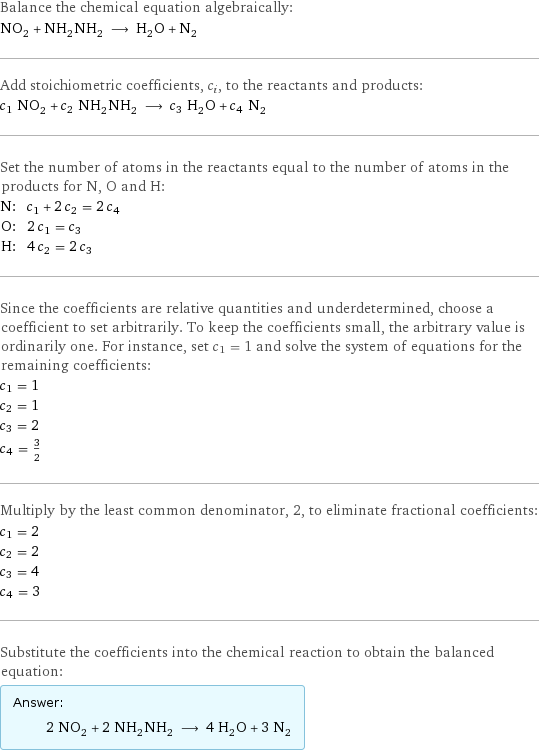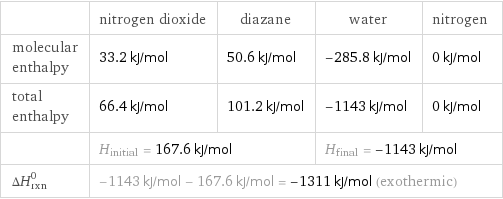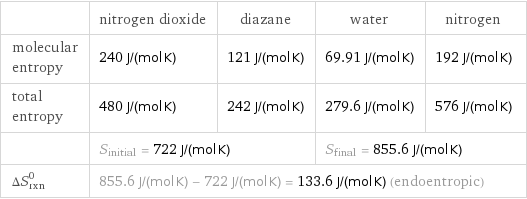Input interpretation

NO_2 nitrogen dioxide + NH_2NH_2 diazane ⟶ H_2O water + N_2 nitrogen
Balanced equation

Balance the chemical equation algebraically: NO_2 + NH_2NH_2 ⟶ H_2O + N_2 Add stoichiometric coefficients, c_i, to the reactants and products: c_1 NO_2 + c_2 NH_2NH_2 ⟶ c_3 H_2O + c_4 N_2 Set the number of atoms in the reactants equal to the number of atoms in the products for N, O and H: N: | c_1 + 2 c_2 = 2 c_4 O: | 2 c_1 = c_3 H: | 4 c_2 = 2 c_3 Since the coefficients are relative quantities and underdetermined, choose a coefficient to set arbitrarily. To keep the coefficients small, the arbitrary value is ordinarily one. For instance, set c_1 = 1 and solve the system of equations for the remaining coefficients: c_1 = 1 c_2 = 1 c_3 = 2 c_4 = 3/2 Multiply by the least common denominator, 2, to eliminate fractional coefficients: c_1 = 2 c_2 = 2 c_3 = 4 c_4 = 3 Substitute the coefficients into the chemical reaction to obtain the balanced equation: Answer: | | 2 NO_2 + 2 NH_2NH_2 ⟶ 4 H_2O + 3 N_2
Structures

+ ⟶ +
Names

nitrogen dioxide + diazane ⟶ water + nitrogen
Reaction thermodynamics
Enthalpy

| nitrogen dioxide | diazane | water | nitrogen molecular enthalpy | 33.2 kJ/mol | 50.6 kJ/mol | -285.8 kJ/mol | 0 kJ/mol total enthalpy | 66.4 kJ/mol | 101.2 kJ/mol | -1143 kJ/mol | 0 kJ/mol | H_initial = 167.6 kJ/mol | | H_final = -1143 kJ/mol | ΔH_rxn^0 | -1143 kJ/mol - 167.6 kJ/mol = -1311 kJ/mol (exothermic) | | |
Gibbs free energy

| nitrogen dioxide | diazane | water | nitrogen molecular free energy | 51.3 kJ/mol | 149.3 kJ/mol | -237.1 kJ/mol | 0 kJ/mol total free energy | 102.6 kJ/mol | 298.6 kJ/mol | -948.4 kJ/mol | 0 kJ/mol | G_initial = 401.2 kJ/mol | | G_final = -948.4 kJ/mol | ΔG_rxn^0 | -948.4 kJ/mol - 401.2 kJ/mol = -1350 kJ/mol (exergonic) | | |
Entropy

| nitrogen dioxide | diazane | water | nitrogen molecular entropy | 240 J/(mol K) | 121 J/(mol K) | 69.91 J/(mol K) | 192 J/(mol K) total entropy | 480 J/(mol K) | 242 J/(mol K) | 279.6 J/(mol K) | 576 J/(mol K) | S_initial = 722 J/(mol K) | | S_final = 855.6 J/(mol K) | ΔS_rxn^0 | 855.6 J/(mol K) - 722 J/(mol K) = 133.6 J/(mol K) (endoentropic) | | |
Equilibrium constant
![Construct the equilibrium constant, K, expression for: NO_2 + NH_2NH_2 ⟶ H_2O + N_2 Plan: • Balance the chemical equation. • Determine the stoichiometric numbers. • Assemble the activity expression for each chemical species. • Use the activity expressions to build the equilibrium constant expression. Write the balanced chemical equation: 2 NO_2 + 2 NH_2NH_2 ⟶ 4 H_2O + 3 N_2 Assign stoichiometric numbers, ν_i, using the stoichiometric coefficients, c_i, from the balanced chemical equation in the following manner: ν_i = -c_i for reactants and ν_i = c_i for products: chemical species | c_i | ν_i NO_2 | 2 | -2 NH_2NH_2 | 2 | -2 H_2O | 4 | 4 N_2 | 3 | 3 Assemble the activity expressions accounting for the state of matter and ν_i: chemical species | c_i | ν_i | activity expression NO_2 | 2 | -2 | ([NO2])^(-2) NH_2NH_2 | 2 | -2 | ([NH2NH2])^(-2) H_2O | 4 | 4 | ([H2O])^4 N_2 | 3 | 3 | ([N2])^3 The equilibrium constant symbol in the concentration basis is: K_c Mulitply the activity expressions to arrive at the K_c expression: Answer: | | K_c = ([NO2])^(-2) ([NH2NH2])^(-2) ([H2O])^4 ([N2])^3 = (([H2O])^4 ([N2])^3)/(([NO2])^2 ([NH2NH2])^2)](../image_source/5dafbcb77a5b430e57816e0e6e525769.png)
Construct the equilibrium constant, K, expression for: NO_2 + NH_2NH_2 ⟶ H_2O + N_2 Plan: • Balance the chemical equation. • Determine the stoichiometric numbers. • Assemble the activity expression for each chemical species. • Use the activity expressions to build the equilibrium constant expression. Write the balanced chemical equation: 2 NO_2 + 2 NH_2NH_2 ⟶ 4 H_2O + 3 N_2 Assign stoichiometric numbers, ν_i, using the stoichiometric coefficients, c_i, from the balanced chemical equation in the following manner: ν_i = -c_i for reactants and ν_i = c_i for products: chemical species | c_i | ν_i NO_2 | 2 | -2 NH_2NH_2 | 2 | -2 H_2O | 4 | 4 N_2 | 3 | 3 Assemble the activity expressions accounting for the state of matter and ν_i: chemical species | c_i | ν_i | activity expression NO_2 | 2 | -2 | ([NO2])^(-2) NH_2NH_2 | 2 | -2 | ([NH2NH2])^(-2) H_2O | 4 | 4 | ([H2O])^4 N_2 | 3 | 3 | ([N2])^3 The equilibrium constant symbol in the concentration basis is: K_c Mulitply the activity expressions to arrive at the K_c expression: Answer: | | K_c = ([NO2])^(-2) ([NH2NH2])^(-2) ([H2O])^4 ([N2])^3 = (([H2O])^4 ([N2])^3)/(([NO2])^2 ([NH2NH2])^2)
Rate of reaction
![Construct the rate of reaction expression for: NO_2 + NH_2NH_2 ⟶ H_2O + N_2 Plan: • Balance the chemical equation. • Determine the stoichiometric numbers. • Assemble the rate term for each chemical species. • Write the rate of reaction expression. Write the balanced chemical equation: 2 NO_2 + 2 NH_2NH_2 ⟶ 4 H_2O + 3 N_2 Assign stoichiometric numbers, ν_i, using the stoichiometric coefficients, c_i, from the balanced chemical equation in the following manner: ν_i = -c_i for reactants and ν_i = c_i for products: chemical species | c_i | ν_i NO_2 | 2 | -2 NH_2NH_2 | 2 | -2 H_2O | 4 | 4 N_2 | 3 | 3 The rate term for each chemical species, B_i, is 1/ν_i(Δ[B_i])/(Δt) where [B_i] is the amount concentration and t is time: chemical species | c_i | ν_i | rate term NO_2 | 2 | -2 | -1/2 (Δ[NO2])/(Δt) NH_2NH_2 | 2 | -2 | -1/2 (Δ[NH2NH2])/(Δt) H_2O | 4 | 4 | 1/4 (Δ[H2O])/(Δt) N_2 | 3 | 3 | 1/3 (Δ[N2])/(Δt) (for infinitesimal rate of change, replace Δ with d) Set the rate terms equal to each other to arrive at the rate expression: Answer: | | rate = -1/2 (Δ[NO2])/(Δt) = -1/2 (Δ[NH2NH2])/(Δt) = 1/4 (Δ[H2O])/(Δt) = 1/3 (Δ[N2])/(Δt) (assuming constant volume and no accumulation of intermediates or side products)](../image_source/37cb667aee0a96a1e9ab3b1536ae09b7.png)
Construct the rate of reaction expression for: NO_2 + NH_2NH_2 ⟶ H_2O + N_2 Plan: • Balance the chemical equation. • Determine the stoichiometric numbers. • Assemble the rate term for each chemical species. • Write the rate of reaction expression. Write the balanced chemical equation: 2 NO_2 + 2 NH_2NH_2 ⟶ 4 H_2O + 3 N_2 Assign stoichiometric numbers, ν_i, using the stoichiometric coefficients, c_i, from the balanced chemical equation in the following manner: ν_i = -c_i for reactants and ν_i = c_i for products: chemical species | c_i | ν_i NO_2 | 2 | -2 NH_2NH_2 | 2 | -2 H_2O | 4 | 4 N_2 | 3 | 3 The rate term for each chemical species, B_i, is 1/ν_i(Δ[B_i])/(Δt) where [B_i] is the amount concentration and t is time: chemical species | c_i | ν_i | rate term NO_2 | 2 | -2 | -1/2 (Δ[NO2])/(Δt) NH_2NH_2 | 2 | -2 | -1/2 (Δ[NH2NH2])/(Δt) H_2O | 4 | 4 | 1/4 (Δ[H2O])/(Δt) N_2 | 3 | 3 | 1/3 (Δ[N2])/(Δt) (for infinitesimal rate of change, replace Δ with d) Set the rate terms equal to each other to arrive at the rate expression: Answer: | | rate = -1/2 (Δ[NO2])/(Δt) = -1/2 (Δ[NH2NH2])/(Δt) = 1/4 (Δ[H2O])/(Δt) = 1/3 (Δ[N2])/(Δt) (assuming constant volume and no accumulation of intermediates or side products)
Chemical names and formulas

| nitrogen dioxide | diazane | water | nitrogen formula | NO_2 | NH_2NH_2 | H_2O | N_2 Hill formula | NO_2 | H_4N_2 | H_2O | N_2 name | nitrogen dioxide | diazane | water | nitrogen IUPAC name | Nitrogen dioxide | hydrazine | water | molecular nitrogen